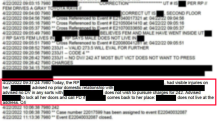Less than two months before Connie Dadkhah was found dead inside her Rancho Penasquitos condo, officers knocked on her door. Her neighbor testified in court that she called police after she heard a scream and saw a man attack Connie on her home security camera. In the video, Connie’s alleged attacker is the same man who is now charged with her murder.

At the time of that attack, police had the legal standing to arrest the suspect, Parrish Chambers Jr. Any contact with Connie would’ve been a violation of Chambers’ probation, according to a court order. But no criminal complaint was filed, and no arrest was made. This month, the prosecutor told a judge she plans to add more charges to the murder case, for that earlier incident.
NBC 7 Investigates obtained video of that violent interaction, but we haven’t been given permission to broadcast or publish it as part of our reporting. Instead, we're using sketches to illustrate some key moments from that video. We believe it’s important for you to know what happened to Connie and what officers did, and did not do.

The home security video shows Connie trying to get away from the suspect on a Friday morning in April. But he catches up to her and grabs at her. At one point she’s shoved so forcefully that she falls forward onto the stairs out of view.
About an hour later, the video shows police officers taking photos of Connie's neck and arm. But not only did officers not make an arrest, the call for service report stated, “no report required.”
Nearly two months later on June 14, investigators say Chambers murdered Connie after he smashed his way in through a glass door on her balcony. An NBC 7 investigation uncovered at least four neighbors called police multiple times begging for help. Police didn’t show up until nearly two hours after the first 911 call, and 45 minutes after one caller reported she witnessed the break-in in real-time.
Once they arrived, officers never went inside Connie’s condo to confront the suspect. Police told NBC 7 they thought he lived there. The next morning, officers found Connie's body on her couch, after they say Chambers asked a neighbor to call 911.
The deputy medical examiner testified in a pre-trial hearing this month that Connie likely died from a brain bleed from injuries to her head. Chambers has pleaded not guilty to murder.
NBC 7 Investigates assembled a panel of experts, showed them the videos, and asked them why they think an arrest wasn’t made.
“If that action had taken place in front of a police officer and they witnessed it, they would have been able to make a misdemeanor arrest,” said Andrew Hoffman, a retired San Diego Police Department lieutenant.
Hoffman says California law doesn’t allow officers to make arrests for misdemeanor crimes they didn’t observe unless the victim or a witness makes a citizen's arrest. In this case, the dispatch report said Connie didn’t want to pursue charges.
But that’s not the case with domestic violence assault and battery, says civil rights attorney Dante Pride.
“Once a situation is characterized as a domestic violence situation, then the officers are able to move forward without the participation of the victim or a witness,” said Pride.
But that April morning, according to the dispatch report, Connie told officers she and the suspect did not have a domestic relationship.

Verna Griffin-Tabor, CEO of the Center for Community Solutions, a nonprofit agency that supports domestic violence survivors, says oftentimes victims of domestic abuse won’t pursue charges. She says better training can help officers discern potential abuse.
“There were many warning signs for law enforcement,” said Griffin-Tabor. “I don’t think the law enforcement entities who showed [in June] knew about that. Had they known, had there been better reporting and better tracking, that could’ve saved Connie's life.”
“If you have multiple calls for service to one location from multiple neighbors there should be a rule that contact needs to be made,” said Pride.
The Center for Community Solutions has a 24-hour toll-free crisis line for domestic violence and sexual assault victims. That number is (888) 385-4657.
